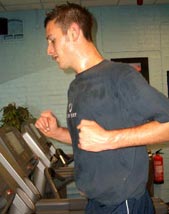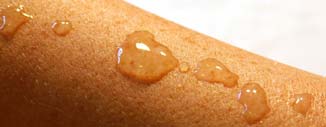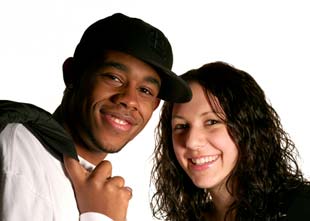What does the skin do?
Skin has many functions and useful properties:
- Control of body temperature
- Keeping out infection
- It´s a waterproof barrier
- Protects delicate tissues underneath
- Mends itself when damaged
Temperature control
Body temperature is normally 37ºC no matter what the temperature of the surroundings. It is controlled by a feedback system, that is, information about the temperature of the body, for example from the temperature sensitive receptors in the skin, is fed back to the hypothalamus, the temperature-regulating centre of the brain. The brain then sends messages to parts of the body, including the skin, to keep heat in or to lose excess heat.
Other feedback systems are used in controlling
the amount of glucose and water in the blood.
Keeping temperature, glucose and water at the right levels is known as homeostasis and is important for the chemical processes of the body to work properly.
If the body is too cold...
...the hairs are raised by small muscles to trap a layer of air near the skin giving the appearance of goose bumps. Air is an insulator so this helps to keep heat in. Shivering, a trembling of the muscles, produces more heat and, during shivering, there is usually an increase in the rate of respiration, which also warms the surrounding tissues.
The rate of heat loss depends on the amount of blood flowing through the skin. When cold, blood is kept away from the surface by vasoconstriction, that is, narrowing of the blood vessels leading to the skin capillaries. Very little blood then flows through these capillaries and this minimises the loss of heat from the skin.
If the body is too hot...

...the blood vessels leading to the skin capillaries dilate, known as vasodilation. This allows lots of blood to flow near the surface and heat is lost through the skin by convection and radiation.
To further reduce the body temperature, sweating occurs. Sweat is mostly water with some salt (sodium chloride). It is produced by the sweat glands and pours out onto the surface of the skin. Here the water evaporates, which removes heat from the skin therefore cooling the skin down. Salt is left on the skin so the skin can taste a bit salty after sweating. If sweating is excessive, too much salt can be lost from the body upsetting the ion balance in the blood which can lead to cramps.
In very hot environments, excessive sweating (up to two pints in an hour) can also lead to dehydration. Dehydration causes a reduction in the amount of sweating and the body temperature stays too high. If this happens, the normal mechanisms for temperature control break down –

It is possible to acclimatise the body over a period of several weeks to hotter conditions. Acclimatisation results in the progressive decrease in salt concentration of sweat, while the volume of sweat increases. This has the advantage of not losing too much salt from the body, and, as long as water intake is adequate, dehydration does not occur. Sportspeople, who normally live in temperate climates, can prepare themselves for sporting events by living and training in the hot conditions for several weeks before the events and in this way can maintain their usual standards while performing in the hot climate.
A waterproof coat

Keratin in the epidermis and oil produced by the sebaceous glands help to make our skin waterproof. This means we don´t go soggy in the bath or dry up in the sun!
Keeping bugs out
Millions of microorganisms live harmlessly on the skin and in the air around us. The skin forms a very effective barrier to stop them entering the body unless damaged, when infections can then occur.
Skin colour
Melanin is a pigment that gives skin a colour from pink through brown to black. People are different colours because their skin contains different amounts of melanin.
Melanin protects skin from ultra-violet (UV) radiation. When skin is exposed to the sun, more melanin is produced and the skin darkens. An albino person has skin which contains no melanin. Therefore they have no natural protection from UV rays. Their skin must be covered up in sunlight.













